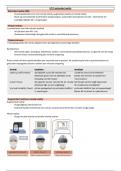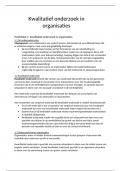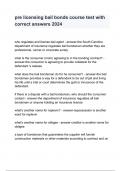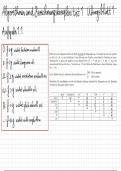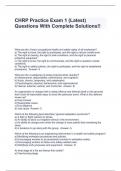Lecture 1 (Chapter 1):
1. How does a limited partnership differ from a limited liability company?
So a partnership is where more than one person (partners) are directly liable for the company
and thus its debts (unlimited personal liability)
There is no eparation between the firm and the owner
Now a limited partnership has two kind of partners:
General partners: same rights and liabilities as partners in a regular partnership (run the
firm on a day by day basis)
Limited partners: limited liability and cannot lose more than their initial investment but
thereby they don’t have management authority and cannot legally be involved in
managerial decision making
Limited liability company (LLC) there the owners have also a limited liability but they can
run the business
So the difference lies in the running of the business or not
Limited partner only limited liability but cannot run the business and the limited liability
company there is also limited liability but there they can run the business
2. What is the principal-agent problem that may exist in a corporation?
The principal-agent problem is a conflict in priorities between a person or a group and the
representative authorized to act on their behalf.
An agent may act in a way that is contrary to the best interests of the principal.
The self-interests of the principal and the agent (authorized) differs.
,3. What advantage does a stock market provide to investors of corporations?
It provides liquidity to shareholders, they have an ability to easily sell an asset for close to the
price at which you can currently buy it.
It is super easy because these stocks are traded on a public stock exchange where everyone
can buy shares.
4. What are dark pools?
Normally with exchange trading, the limit book orders are public which allows investors to
trade at the current bid or ask price and transactions are visible to all traders when they
occur.
But with dark pools, the limit order books are not visible.
Therefore they offer investors the ability to trade at a better price with tradeoff being that
their order might not be filled if an excess of either buy or sell orders is received.
This is mostly for investors that want to buy or sell a large shunk of securities. Then this
would not directly tirgger a drop or rise in the price. (normally when a whale, a holder of a lot
of shares sells of his large shunk of shares, you can see this and a lot of other people are also
going to sell their shares and this will drop the price what is not wished by the whale who
wants to sell his shares for as much as possible.
Lecture 2 (chapter 2):
1. The book value of a company’s assets usually does not equal the market value of those
assets. What are some reasons for this difference?
Book value = acquisition cost – accumulated depreciation
If an asset is used than it loses some value, this is depreciation of the asset(is to
acknowledge the fact that it is used)
Market value vs Book value (dia 21,22)
The market value of equity (market capitalization)
Market price per share X number of shares
This cannot be negative and often differs substantially from the book value
The price moves everyday and therefore the market price is only a snapshot
The market price is affected by the future (future opportunities are taken into account
for the current price)
The book values are not reflecting the future opportunities
There is also a market-to-book ratio (aka price-to-book ratio)
Market-to-book ratio = market value of equity/ book value of equity
When there is a growth it is represented by a high M/B ratio
, Market value tend to be greater because market value captures non-tangibles but future
growth prospects as well.
A company's book value is the amount of money shareholders would receive if assets were
liquidated and liabilities paid off.
The market value is the value of a company according to the markets—based on the current
stock price and the number of outstanding shares.
When the market value is less than book value, the market doesn't believe the company is
worth the value on its books.
A higher market value than book value means the market is assigning a high value to the
company due to expected earnings increases.
2. What is a firm’s enterprise value?
Enterprise value = Market value of equity + debt – cash
Cash because cash can be used to pay off the debts
Can also use net debt (this is the amount of debt left when the cash is used)
3. What is the difference between a firm’s gross profit and its net income?
Gross profit = Total Sales/revenues – Cost of sales
Operating income = Gross Profit – Operating expenses (administrative expenses,
R1D,depreciation & amortization)
Earnings Before interest and taxes (EBIT) = Operating income +(-) other income/ other
expenses
Pre-tax income = EBIT +(-) Interest income/interest expense
Net Income (profits) = Pre-tax income - Taxes
Gross profit is the the amount of money earned with the profit margin on the sales but
doesn’t include other expenses or costs. Also, the taxes are not yet calculated in these
gross profits. This comes only with the net income where also all the other expenses and
incomes are used and calculated in this variable.
Gross profit refers to a company's profits earned after subtracting the costs of
producing and distributing its products. Net income indicates a
company's profit after all of its expenses have been deducted from revenues.
1. How does a limited partnership differ from a limited liability company?
So a partnership is where more than one person (partners) are directly liable for the company
and thus its debts (unlimited personal liability)
There is no eparation between the firm and the owner
Now a limited partnership has two kind of partners:
General partners: same rights and liabilities as partners in a regular partnership (run the
firm on a day by day basis)
Limited partners: limited liability and cannot lose more than their initial investment but
thereby they don’t have management authority and cannot legally be involved in
managerial decision making
Limited liability company (LLC) there the owners have also a limited liability but they can
run the business
So the difference lies in the running of the business or not
Limited partner only limited liability but cannot run the business and the limited liability
company there is also limited liability but there they can run the business
2. What is the principal-agent problem that may exist in a corporation?
The principal-agent problem is a conflict in priorities between a person or a group and the
representative authorized to act on their behalf.
An agent may act in a way that is contrary to the best interests of the principal.
The self-interests of the principal and the agent (authorized) differs.
,3. What advantage does a stock market provide to investors of corporations?
It provides liquidity to shareholders, they have an ability to easily sell an asset for close to the
price at which you can currently buy it.
It is super easy because these stocks are traded on a public stock exchange where everyone
can buy shares.
4. What are dark pools?
Normally with exchange trading, the limit book orders are public which allows investors to
trade at the current bid or ask price and transactions are visible to all traders when they
occur.
But with dark pools, the limit order books are not visible.
Therefore they offer investors the ability to trade at a better price with tradeoff being that
their order might not be filled if an excess of either buy or sell orders is received.
This is mostly for investors that want to buy or sell a large shunk of securities. Then this
would not directly tirgger a drop or rise in the price. (normally when a whale, a holder of a lot
of shares sells of his large shunk of shares, you can see this and a lot of other people are also
going to sell their shares and this will drop the price what is not wished by the whale who
wants to sell his shares for as much as possible.
Lecture 2 (chapter 2):
1. The book value of a company’s assets usually does not equal the market value of those
assets. What are some reasons for this difference?
Book value = acquisition cost – accumulated depreciation
If an asset is used than it loses some value, this is depreciation of the asset(is to
acknowledge the fact that it is used)
Market value vs Book value (dia 21,22)
The market value of equity (market capitalization)
Market price per share X number of shares
This cannot be negative and often differs substantially from the book value
The price moves everyday and therefore the market price is only a snapshot
The market price is affected by the future (future opportunities are taken into account
for the current price)
The book values are not reflecting the future opportunities
There is also a market-to-book ratio (aka price-to-book ratio)
Market-to-book ratio = market value of equity/ book value of equity
When there is a growth it is represented by a high M/B ratio
, Market value tend to be greater because market value captures non-tangibles but future
growth prospects as well.
A company's book value is the amount of money shareholders would receive if assets were
liquidated and liabilities paid off.
The market value is the value of a company according to the markets—based on the current
stock price and the number of outstanding shares.
When the market value is less than book value, the market doesn't believe the company is
worth the value on its books.
A higher market value than book value means the market is assigning a high value to the
company due to expected earnings increases.
2. What is a firm’s enterprise value?
Enterprise value = Market value of equity + debt – cash
Cash because cash can be used to pay off the debts
Can also use net debt (this is the amount of debt left when the cash is used)
3. What is the difference between a firm’s gross profit and its net income?
Gross profit = Total Sales/revenues – Cost of sales
Operating income = Gross Profit – Operating expenses (administrative expenses,
R1D,depreciation & amortization)
Earnings Before interest and taxes (EBIT) = Operating income +(-) other income/ other
expenses
Pre-tax income = EBIT +(-) Interest income/interest expense
Net Income (profits) = Pre-tax income - Taxes
Gross profit is the the amount of money earned with the profit margin on the sales but
doesn’t include other expenses or costs. Also, the taxes are not yet calculated in these
gross profits. This comes only with the net income where also all the other expenses and
incomes are used and calculated in this variable.
Gross profit refers to a company's profits earned after subtracting the costs of
producing and distributing its products. Net income indicates a
company's profit after all of its expenses have been deducted from revenues.


